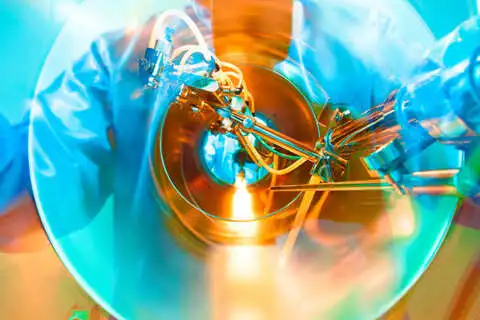Cleanroom and Controlled Environment Standards

Cleanroom and Controlled Environment Standards are in use in many types of laboraties. With IEST, the Institute of Environmental Sciences and Technology, paying particular emphasis to vital role cleanrooms play in electronics production and testing, published standards are useful for a wide range of applications and industries.
IEST-G-CC035.1
Design Considerations for Airborne Molecular Contamination Filtration Systems in Cleanrooms and Other Controlled Environments
IEST-RP-CC001.6
HEPA and ULPA Filters
This Recommended Practice (RP) covers basic provisions for HEPA (high efficiency particulate air) and ULPA (ultra-low penetration air) filter units as a basis for agreement between customers and suppliers. Filters that meet the requirements of this RP are suitable for use in clean air devices and cleanrooms that fall within the scope of ISO 14644 and for use in supply air and contaminated exhaust systems that require extremely high filter efficiency (99.97% or higher) for submicrometer (╡m) particles. This RP describes 11 levels of filter performance, or types, and five grades of filter construction. For the types and grades that require scanning, these filter types generally apply to rectangular filters. Semi-circular, cylindrical, V-bank filters and other construction configurations may not be readily scanned and thus will not meet the require-ments of the filter types requiring scanning. While many of the performance measurement techniques can be adapted to other filter configurations, the filter types as described in this RP should be applied only to rectangular, flat panel filters. The customerÆs purchase order should specify the level of performance and grade of construction required. The customer should also specify the filter efficiency required if the efficiency level is not covered by the perfor-mance levels specified in this RP. NOTE: Products and procedures discussed in this RP may involve hazardous materials, operations, and equipment. This RP does not purport to address all of the safety problems associated with its use. It is the responsibility of the user to consult and establish appropriate safety and health practices and to determine the applicability of regulatory limita-tions prior to use of this RP.
IEST-RP-CC002.4
Unidirectional-Flow, Clean-Air Devices
This Recommended Practice (RP) covers definitions, procedures for evaluating performance, and major require-ments of unidirectional-flow, clean-air devices. The RP may be used to define a basis of agreement between cus-tomer and supplier in the specification, procurement, and certification testing of unidirectional-flow, clean-air devices with self-contained motor-blower(s) and powered terminal units with replaceable filters. This document also presents recommendations for recertification of devices owned by the customer, under direction of the customer.
IEST-RP-CC005.4
Gloves and Finger Cots Used in Cleanrooms and Other Controlled Environments Arlington Place
This Recommended Practice (RP) describes procedures for testing and evaluating gloves and finger cots used in cleanrooms and other controlled environments. Tests are provided for determining cleanliness, physical and chemical integrity, and other relevant properties. Guidelines are also provided to assist users in the proper selection of gloves or finger cots.
IEST-RP-CC007.3
Testing ULPA Filters
This Recommended Practice (RP) describes the equipment, aerosol properties, processes, and calculations for determining the efficiency of ULPA and super ULPA filters in the factory, using particle counters. The procedure may be applied to production applications. This RP provides guidelines for constructing a suitable test duct and sampling system. Also provided are test criteria for quantifying penetration in the range of 0.0010% to 0.00010%, using test aerosol particles in the size range of 0.1 to 0.2 ╡m.
IEST-RP-CC021.4
Testing HEPA and ULPA Filter Media
This Recommended Practice (RP) discusses test methods for physical and filtration properties of high-efficiency particulate air (HEPA) and ultra-low penetration air (ULPA) filtration media. Application of this RP is by mutual agreement between the customer and the supplier. Use of this RP should be ap-plied, but not be limited to: a) Acceptance criteria for test methods; b) Test aerosol and particle size; c) Test face velocity.
IEST-RP-CC034.4
HEPA and ULPA Filter Leak Tests
This Recommended Practice (RP) covers definitions, equipment, and procedures for leak testing high-efficiency particulate air (HEPA) filters and ultralow-penetration air (ULPA) filters in the factory as they are produced, at the job site before they are installed, and after they are installed in cleanrooms and in unidirectional-flow, clean-air de-vices. When used in conjunction with other RPs, including IEST-RP-CC001, IEST-RP-CC002, IEST-RP-CC006, IEST-RP-CC007, IEST-RP-CC021, IEST-RP-CC028, and IEST-RP-CC036, this RP may be used to define the basis of an agreement between the customer and supplier in the specification and procurement of HEPA and ULPA filters, and in the testing of these filters in unidirectional-flow, clean-air devices and cleanrooms. This RP also includes procedures for measuring the uniformity of the aerosol challenge approaching the filter under test. Although the scanning methods in the factory and in situ (in the field) appear similar, they are not identical, mainly due to increased variability for in-situ testing. In this revision of the RP, the recommended procedures for factory and in-situ testing are separated for ease of use. In factory and in-situ testing, if a leak is detected while scanning a filter, it is recommended that the magnitude of the leak be quantified with the scanning probe stationary over the detected leak.





